If You Have Trouble Collecting Data with Your Water Quality Sonde, Try These Steps
Have you ever spent the time to set up and calibrate a sonde, make the effort to deploy it in the field, and then discover that it didn’t collect any data? Occasionally, this unfortunate scenario occurs. Here are some tips to troubleshoot this problem to prevent it from happening. 
Make Sure the Instrument Has a Sufficient Power Source
If you are using the instrument’s internal batteries:
- Be sure to check the voltage and polarity. Sometimes even new batteries have low voltage or reversed polarity and even one bad battery can shorten the life of the rest of them.
- Be sure the batteries were installed in the proper orientation. Many instruments have a decal or imprinted instructions regarding proper battery installation. The small, extra effort is worth making sure you gather your data. Also be sure to make sure the battery terminals are intact, clean, and free of corrosion. We know you know how to install batteries, but we can assure you that our Tech Support department will ask you to check the orientation and we only do this because, you guessed it, people do get this incorrect.
- Battery compartments should be dry and free of debris. You may need to consult the instrument’s manual or support person for proper cleaning techniques.
- Battery compartment o-rings should be in good condition, clean, and free of nicks or creases indicating the o-rings may have been pinched. O-rings should be replaced if they are loose-fitting, damaged, or deformed. Be sure to grease the o-rings to optimize their flexibility and to prevent them from drying out. Always use the manufacturer’s recommended o-ring grease. YSI recommends using Silicone or Krytox. Do not use too much grease as this will inhibit the o-ring’s ability to properly seal.
For externally powered applications such as dataloggers or telemetry systems:
- Check the wiring or the instrument’s cable for connection issues. Check the cable for continuity or swap it with another to ensure power is being provided to the sonde. Make sure the connection on the sonde, where the cable attaches, is dry and free of corrosion or debris.
- Be sure the right sized battery is being used for the amount of instrumentation connected to your datalogger or telemetry system. A power consumption budget should be performed if multiple instruments will be relying on the same external battery. In addition, using a solar regulator is a good idea so the external battery isn’t overcharged. In contrast, make sure the regulator has a low voltage cut-off so the battery isn’t damaged from the voltage becoming too low. The battery won’t take a charge if the voltage has dropped too low and it will likely need to be replaced if this happens.
- When utilizing solar panels to recharge the battery, be mindful of its location for optimum charging. Make sure the solar panels are not installed in a shaded area and they stay clean. Tree debris or, yes, heavy bird droppings...will prevent the battery from charging sufficiently.
If it was determined the power was not the issue:
- Make sure the instrument was set up properly by looking at the logging setup for clues.
- Be sure the logging program was started. Some instruments have the option to start immediately or at a later date and time.
- Check the date and time on the instrument. If the date and time or time zone adjustment on your instrument is incorrect, then the instrument may never start logging data.
- Make sure the instrument had enough free memory to log additional data. Many instruments will just stop logging (or never start) if the memory is full.
- Look for hardware failures. Probe or sonde failures may affect the sonde’s ability to collect data. Some instruments log internal faults indicating there is a problem. Check to see if any faults are present and get an explanation.
- If your sonde is connected to a datalogger or telemetry system and it is being powered but it is not displaying data, verify the sonde’s address matches what was programmed in the datalogger. No data will be displayed if the addresses don’t match.
Once you have gone through troubleshooting, run the instrument in a controlled environment to ensure it is working properly before the next deployment. This will help prevent a recurrence of the lack of data collection and ensure the instrument is now working as expected.

Additional Blog Posts of Interest:
Trouble Downloading Your YSI Software? Try This!
5 Easy Steps: Replacing the Optical DO Sensor Cap on YSI EXO Sondes
YSI Expert Tip 1 of 7 - Get Your Water Quality Sonde Field Ready
Top 5 Challenges to Collecting Water Quality Data - Challenge 1